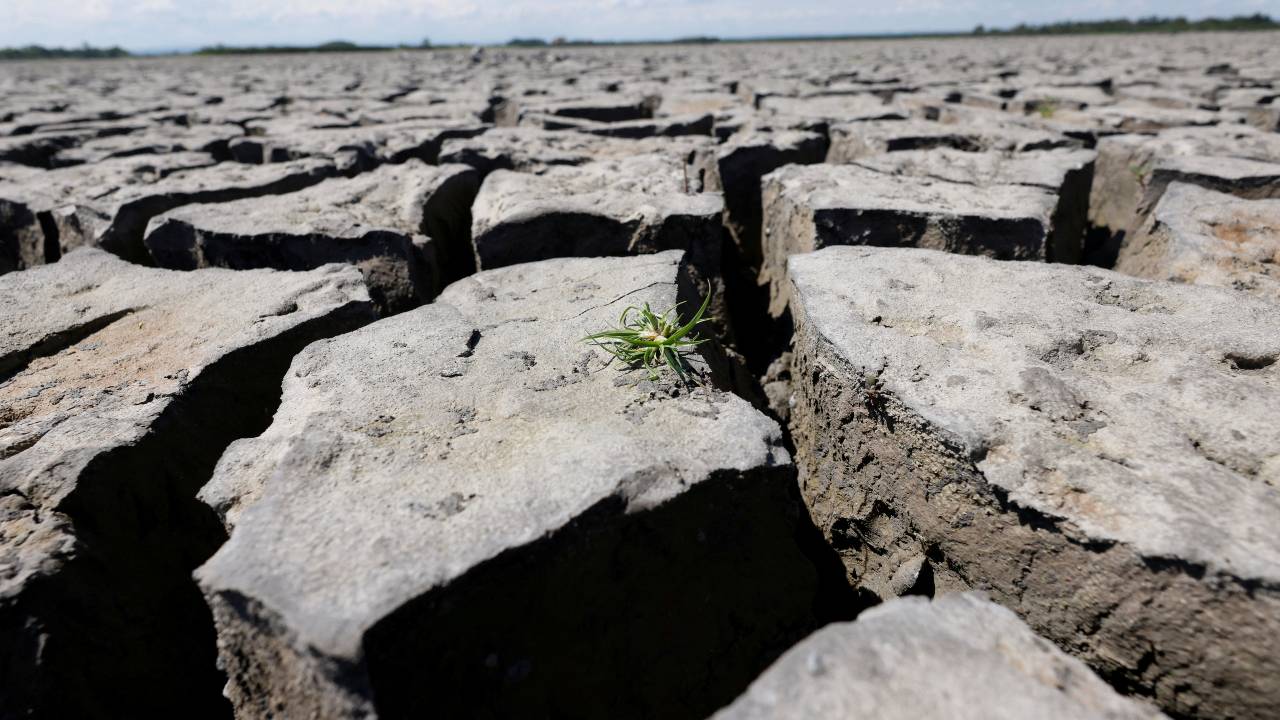
Europe is in the grips of a dry spell that could see its worst drought in 500 years. /Leonhard Foeger/Reuters
Europe is in the grips of a dry spell that could see its worst drought in 500 years. /Leonhard Foeger/Reuters
In famously rainy England, the government formally declared a drought on Friday amid one of the hottest and driest summers on record. Last week, France and Spain's leaders announced that their countries were going through the "most severe drought" ever recorded.
With no significant rainfall for almost two months in much of the continent, Europe is in the grips of an acute dry spell that experts say could mean its worst drought in 500 years.
So which countries are being hit hardest, how does this year's extreme climatic conditions compare to previous decades, and which countries and industries are losing the most money?
READ MORE
CGTN special: Cost-of-living crisis across Europe
Meet the 'sappers' dealing with Ukraine’s unexploded bombs
Which food has the worst environmental impact?
Where are Europe's droughts the worst at the moment?
Amid deadly wildfires in France and Spain, and record temperatures in the UK, the European Commission's Joint Research Centre (JRC) announced last week that almost half of the landmass of the European Union (EU) and UK is at risk of drought.
Following an uncommonly dry start to the year and a winter-spring precipitation deficit of 19 percent across the continent, there has been almost a fifth less average rainfall than over the past 30 years.
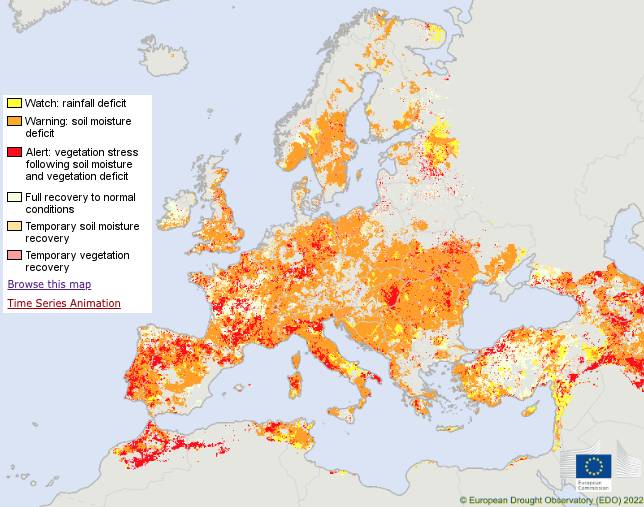
Latest map of the Combined Drought Indicator in Europe and the UK. /European Drought Observatory
Latest map of the Combined Drought Indicator in Europe and the UK. /European Drought Observatory
And with a series of early heatwaves exacerbating the impact of low rainfall, more than 10 percent of the bloc is on high alert level.
The effect has been hardest on central and southern Europe, with soil water content reduced significantly, making it harder for plants to take up water from the soil.
This has led to widespread stress on vegetation, particularly in central Germany, eastern Hungary, the Italian lowlands, southern, central and western France, Portugal and northern Spain.
Italy's Po River basin, one of the country's most important water sources, has been particularly harshly hit, with a drought emergency declared in five regions and multiple water restrictions.
Similar measures have been taken in France, while in Spain's Iberian Peninsula, water reservoir reserves are currently 31 percent lower than the 10-year average.
Hitting agriculture across Europe's south, Romania, Poland, Slovenia and Croatia will also need to deal with dramatically reduced crop yields, according to the JRC, who warned that "extraordinary water and energy management measures" may have to be taken.
How does this year's droughts compare to the last decade?
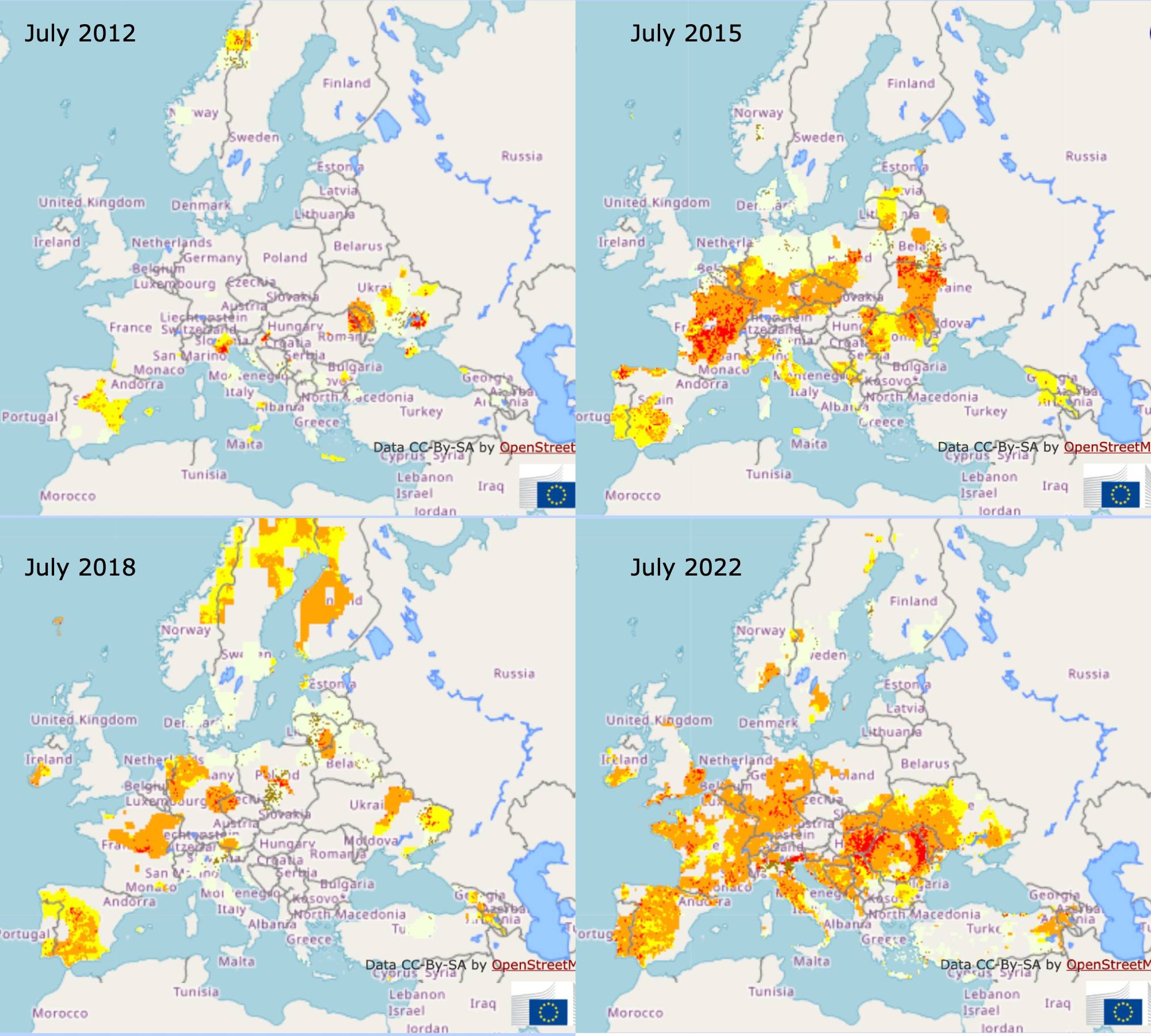
Combined Drought Indicator in Europe and the UK in July 2012, 2015, 2018, and 2022. /European Drought Observatory
Combined Drought Indicator in Europe and the UK in July 2012, 2015, 2018, and 2022. /European Drought Observatory
In terms of duration and scope, this year's Europe-wide drought is worse than anything the continent has experienced in nearly 70 years.
Looking back over the last decade, data from the European Drought Observatory shows that droughts are currently more widespread, with vegetation stress as well as rain and soil moisture deficits significantly more prevalent compared to July 2012, 2015, and 2018.
Scandinavian nations are lucky in not having been hit as hard as they were in the summer of 2018, where the region found itself unprepared for its worst drought in more than seven decades.
Specifically in terms of drought - intimately connected to heatwaves, but not the same thing - senior JRC researcher Andrea Toreti said this week that the current dry spell could be the worst in 500 years.
"We haven't analysed the event fully because it is still ongoing, but based on my experience I think that this is perhaps even more extreme than 2018," he said.
"Just to give you an idea, the 2018 drought was so extreme that, looking back at least over the last 500 years, there were no other events similar to the drought of 2018. But this year I think it really is worse."
How has Europe's economy been affected by increased drought?
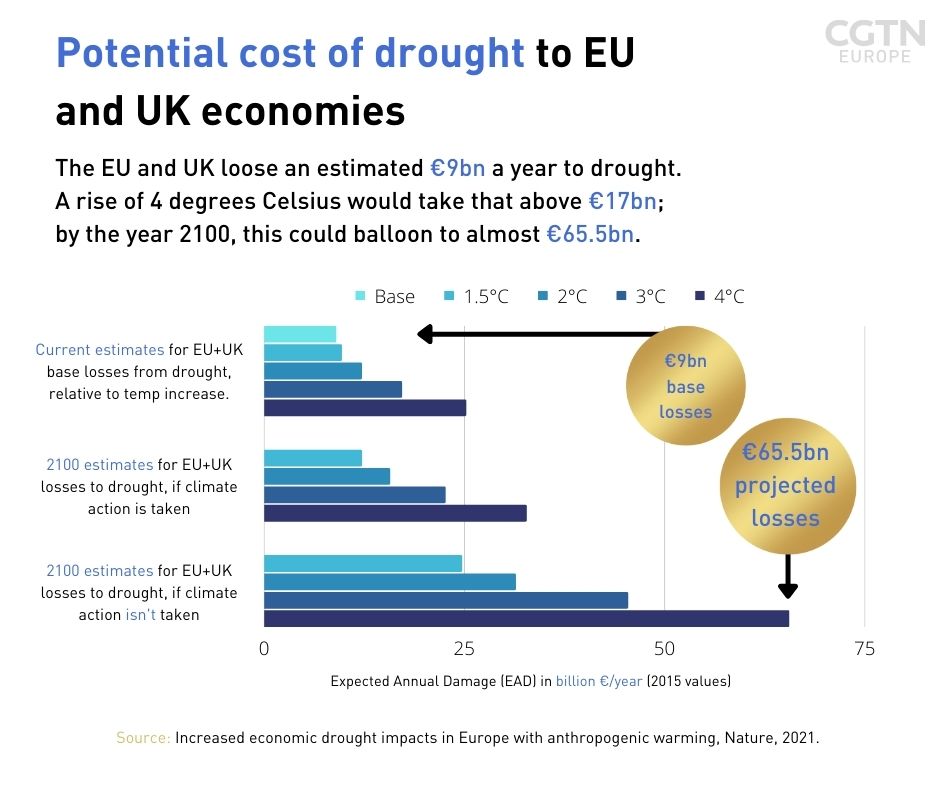
The potential cost of drought to the EU and EU's economies. /Thomas Wintle/CGTN Europe
The potential cost of drought to the EU and EU's economies. /Thomas Wintle/CGTN Europe
Drought cost money. A 2022 study published in Environmental Research Letters reports that the severity of crop losses driven by heatwaves and drought have tripled in the last fifty years in Europe, with global economic losses of from 1998 to 2017 coming to roughly $124 billion.
Research published last year estimates that drought currently costs the EU and UK more than €9 billion ($9.24bn) a year. If temperatures were to rise by 1.5 degrees Celsius - which is what scientists predict within ten years - that figure jumps to €9.68 billion ($9.93bn).
Without significant climate crisis adaptation, the report says that by the year 2100, if temperatures go up by 4 degrees Celsius (estimates range between a 1.1 to 5.4 degree increase) that cost will hit over 65.5 billion a year.
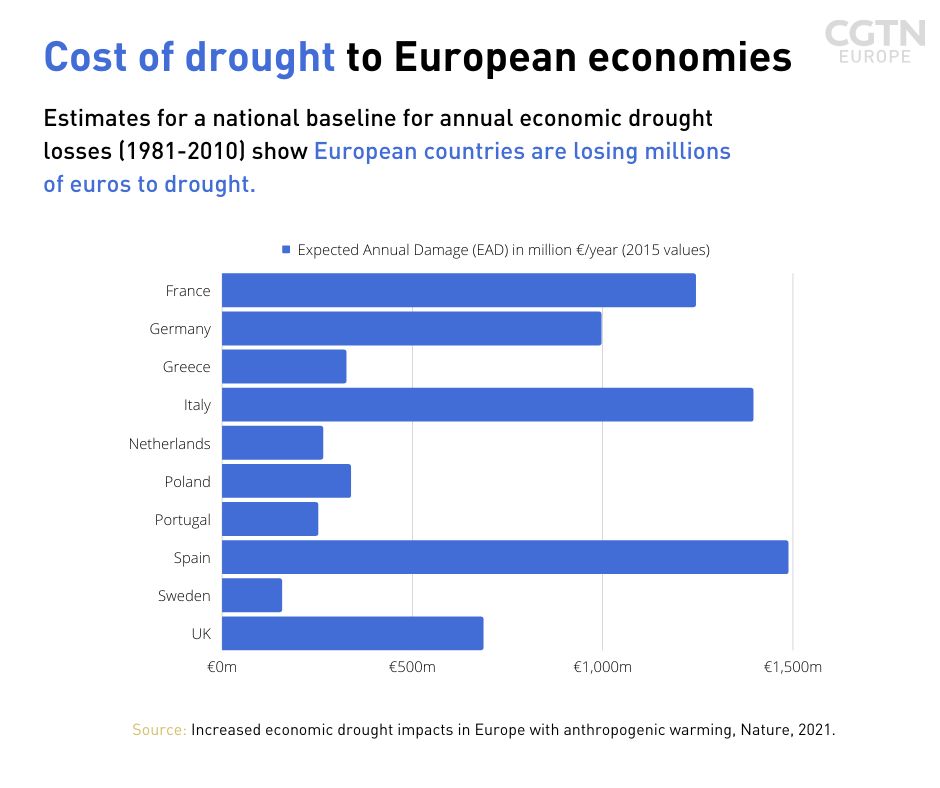
The cost of drought to European economies. /Thomas Wintle/CGTN Europe
The cost of drought to European economies. /Thomas Wintle/CGTN Europe
Spain is currently the European country losing the most money to drought, shedding an estimated €1.487 billion ($1.526bn) a year, according to the report's baseline estimates inferred from data taken between 1981 and 2010,
Italy and France take second and third place, losing an estimated €1.395 billion ($1.432bn) and €1.244 billion ($1.278bn) respectively annually. Germany comes in fourth at €996 million ($1.022bn), followed by the UK at €686 million ($704m).
Going forward, southern European countries like Portugal, Spain, and Croatia are expected to be the worst affected, with potential loses of around 2 percent of GDP in 2040 to around 3 percent in 2060.
As for this year, European Commission climate analyst David Garcia Leon says that 2022 could be comparable to 2003 in terms of general heat intensity, which he says was the most extreme year in the last 40, with estimated EU losses of more than €8.7 billion ($8.93bn).
"If that was the case, aggregate economic losses triggered by heatwaves could be comparable (or even larger) to those experienced back in 2003," he tells CGTN Europe.
Garcia Leon says that his and his colleagues' research from 2021 on current and projected regional economic impacts of heatwaves in Europe had predicted losses between 2021 and 2034 at above 0.5 percent of GDP.
"This intensity was foreseen," he says of this year's economic impact, "although, perhaps, not so soon."
4.) Which industries have been hardest hit?
Unsurprisingly, Garcia Leon's work suggests that in terms of its impact on different European industries, drought harms the agriculture sector the most.
This year alone, France's corn harvest is expected to be almost 20 percent lower than 2021, according to the Agriculture Ministry, while Romania's cereal crop is predicted to drop by 30 million tonnes.
According to the report, agricultural losses made up a sizable chunk of the losses in 2003, 2010, 2015, and 2018 in European regions with more heat prone environments and/or more exposed economic structures, like Spain's Aragon and Portugal's Alentejo.
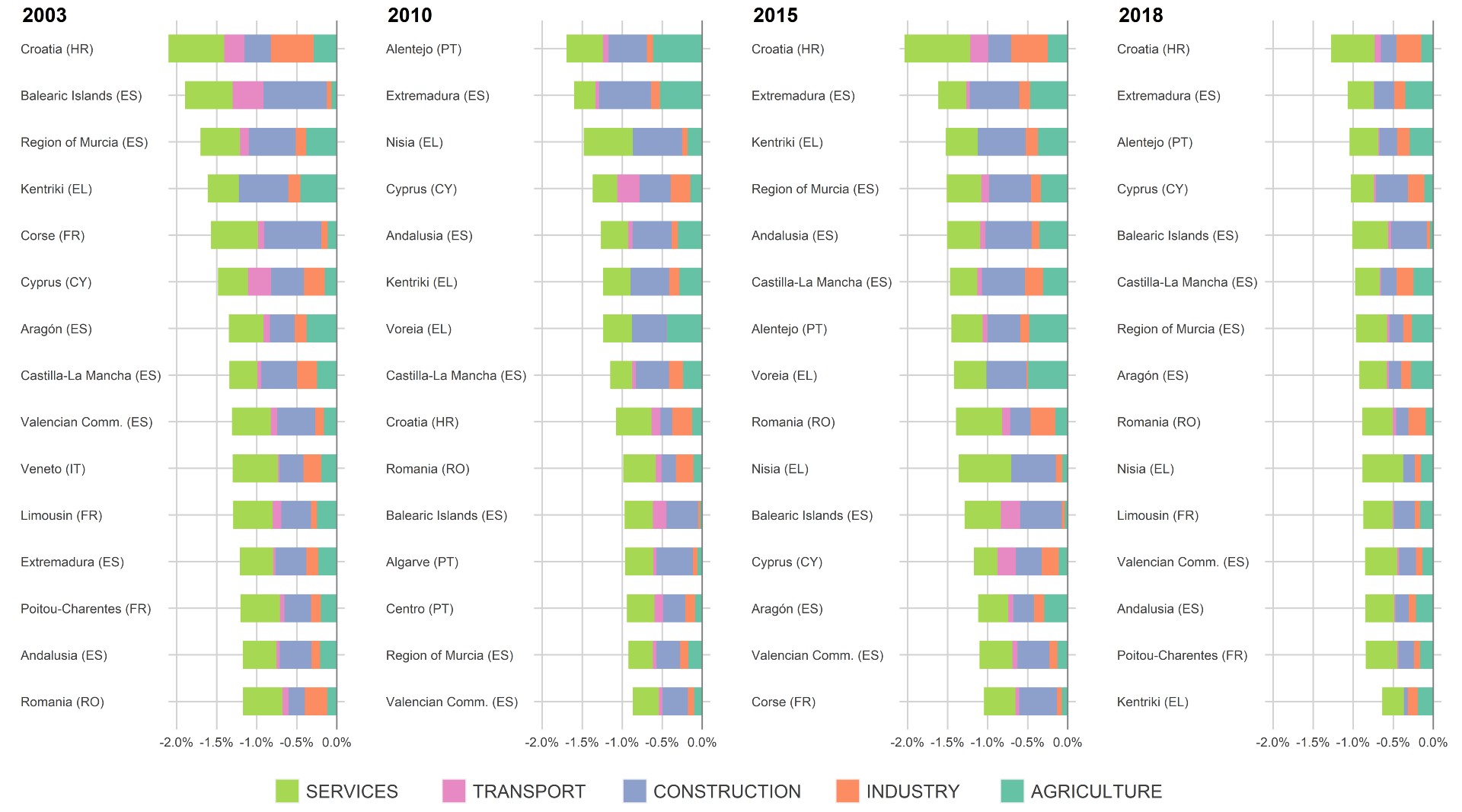
The breakdown of damages to different industries in Europe's regions most affected by extreme heat events. The percentage points show the total percentage variation of the respective regional Gross Value Added. /'Current and projected regional economic impacts of heatwaves in Europe', Nature
The breakdown of damages to different industries in Europe's regions most affected by extreme heat events. The percentage points show the total percentage variation of the respective regional Gross Value Added. /'Current and projected regional economic impacts of heatwaves in Europe', Nature
But drops in farming yields also put direct stress on sectors dependent on agricultural inputs, such as food manufacturing, tourism, and travel-related services, which the data shows is heavily affected.
Garcia Leon says that most losses between the economic sectors mainly happen due to industries being reliant on agricultural and industrial products or transport services that are affected by drought.
For example, this year's drought has left Europe's great rivers dangerously low, which has had a knock on effect on freight. Italy's biggest reservoir of fresh water, the Po river, is a vital waterway for industry and is currently down by two meters.
In Germany, low levels along the Rhine means that cargo transport may have to be reduced or suspended. This has a direct impact on a wide range of sectors, as the river, which snakes from the Alps to the seaports of Rotterdam and Antwerp, is relied on to transport industrial raw materials like coal to fire electricity-making power plants.
This year production at hydroelectric plants has been significantly lower than the average for many European countries in the six years prior, notably in Italy, France, and Portugal, according to the JRC's Drought in Europe - July 2022 report.
These factors, in turn, affects the prices of doing business for nearly all industries, meaning that general long-term economic growth suffers as well.
With Europe's drought expected to continue into September, the JCB lists a number of "unfavourable forecasts" for the coming months, including an early warning to the energy industry.
The report stresses that though drought mitigation strategies are of the "utmost importance" now to protect Europe's economy, "so is tackling the root cause of the problem: climate change and its disruption of the planet's water cycle."

